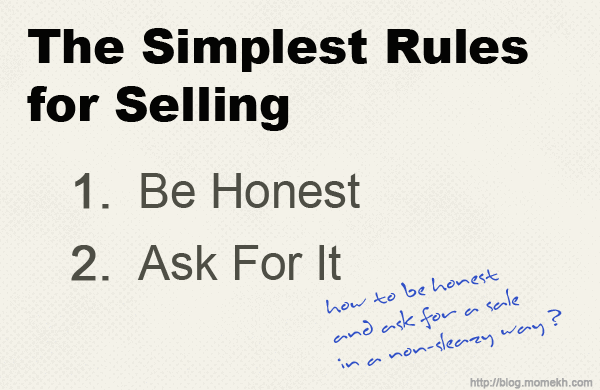Some back story:
Selling to Friends
I just came back from yet another “cup of coffee” with a friend — which is what it sounds like but can also qualify as a sales call.
I am working on a new project: a product that helps people become independent publishers. The idea is to remove all “techy stuff” hassles and leave the people to create and share meaningful content, in a professional manner. It is still in the early stages and I am selling via word of mouth.
The product comes with mentoring and training. The price points are very attractive and so far, very promising Alhumdulillah.
I am following the basic startup methodologies (that I have also taught). The product I am selling right now has about 20 customers, and I plan to “open” it a bit once I reach about 40 customers. InshAllah. Right now, it is simply “word of mouth” and by God’s Grace, it is working out nicely.
+++
I admit; sales is difficult. It feels non-natural sometimes. The following advice can help you sell whatever you’re trying to sell, in a non-sleazy, friendly way God willing.
The Simplest Advice
The simplest advice is “be honest and ask for it”.

But how do you be honest? And isn’t it uncomfortable “asking for a sale” from your friend?
It is.
It is difficult selling to friends. That is why it is my ultimate test. If I am comfortable selling to friends, then I am doing good.
With friends, you can not be sleazy. You are looking out for them, as good friends always do. The only difference here is that you are charging them money for it.
Money, I confess, is not an easy topic. It makes for a difficult conversation. Involving money in an honest, transparent way is tricky, but required. To be non-sleazy, you need to be honest, right? And honesty can be hard.
Here’s a good way to start practicing:
1. Start with Why
Why are you selling what you’re selling? Once you are clear on the “purpose” of your product, it becomes so much easier to “talk about it” in a non-sleazy way.
A good product helps others. It solves a problem that others face. Also, once you are clear on your “Why”, then it is ten times easier to sell.
“People do not buy what you do, they buy why you do it” ~ Simon Sinek
Starting with Why usually means that you end up using “emotional” words. Phrases like, “I believe that this product can…” or “I feel that this will help you really achieve what you are trying to do…” etc. Basically, that’s how we tend to talk with our friends, right?
People respond to your involvement in your product. They respond to your authenticity.
To learn more about Simon Sinek’s work on Starting With Why, you can follow this link.
2. Be Focused on Helping, Rather than “Describing”
Do not try to describe your product or service.
Instead, talk how your friend can benefit from your offering. Keep the conversation about your friend; you are trying to help him/her after all, so it would make sense to talk about his problem and how the product/service can benefit him, instead of how good your product/service is.
This is the real-world application of “features versus benefits”. When selling, talk how the buyer will benefit from your offering, not what cool features the product has.
3. Be Involved
When you are involved, you are excited. You keep talking about it.
This may bore people who are not interested, and that’s OK; stop talking about it if it is boring them.
Will you talk about the latest football match if your friend really isn’t into football? No you won’t (I hope). But then again, you will bring it up once in a while. Not because you are trying to “trick” the conversation, but because you are “involved” and you are excited!
People can easily see the authenticity. If you are really involved, people will notice. So instead of learning “techniques”, internalize the purpose as to why you created the product/service.
I have lots of friends who love their work and it shows – the fact that it shows means that they are “promoting” their product right.
4. You Never Talk About Your Product, But You Must Offer It
As a rule, you never start with “I have this product”. First, there must be some invitation to talk. The best is when the conversation is about the problem that your product solves.
Talking about problems is actually very easy: think about it, that is what friends usually talk about. The problems we face, we ask around, we discuss, right?
Once you talk about the problem, you automatically will talk about your product/service! This is relatively easy. But what’s not easy is to actually offer to sell that product.
“Hey, I really need to reach more people with my business,” says a friend.
“You do? You know this product I have, this can help you build a community and give you access to the right kind of people.
I totally believe that you will be able to sell more honestly with this method. Do you want me to show you how the product works? If it makes sense to you, I will love it if you buy it from me?”
The above conversation is easy. What’s hard is the last line: the offer to buy from you. It is difficult and I don’t always get this right. I usually end up not saying it. But when I do say it, it flows so naturally. The other person doesn’t frown or raise an eyebrow. The other person can see that it is a product that he may find useful, and he (hopefully) sees the honesty.
5. Demonstrate as Much As You Can
Demonstrations work!
The car salesman knows this, that is why many dealerships allow you to take the car for a spin.
The software industry is also highly dependent on “Demos” to help them sell. Games that offer “free trials” or “lite versions” are another example of demonstrations in play.

It is actually easier to demonstrate a product instead of “describing” how it works. The potential client will fill in the blanks himself, and will ask you any questions that may arise; demonstrations are a great way to sell without being pushy about it.
Demos for products is usually straight forward, but it is sometimes impossible to “demo” a service. When I used to design websites as a freelancer, I used to hate it when people asked for a “sample design”… that took a lot of time and there was no guarantee, and I eventually stopped doing “free samples”.
In our cakes business, we sometimes do samples for bigger orders, otherwise, the demonstrations are just too costly to carry out (the product gets consumed as a result of demonstration!).
But in many cases, you must look into ways of letting the potential client “use” your product or service.
6. Mention A Cheaper/Different Option, If Possible
A friend messaged me, asking me how to start a blog online. He is a journalist at a national TV channel here in Pakistan, and he wanted to start his blog to share his own thoughts. Perfect. During the conversation, I told him about the product I have that can help him become an independent publisher. He wanted to know more. I told him the details, including the price.
He told me it is too expensive for him right now. I told him what I will tell my brother or any other close friend; I told him that because you are just “testing” waters, go with the cheapest option. See how it works, see if this “independent publishing” is for you. Once you feel you are ready, I do believe that my product is the best in the market – but there are other options.
I told him the other options.
That was the ethical thing to do. That is what I would do for my closest family and friends.
This hopefully shows that I am not doing this to “just sell”, but I do want what’s best for him. And because I do sincerely believe that my product is the best in its category, I will want him to buy that.
Making sense?
7. Realize This is a Marathon, Not a Sprint
Can anyone ever “rush relationships”?
Silly question, right? Everyone understands that relationships – of each and every kind – takes time. Communicating and building trust takes time.
A lot of “sales people” want to rush this. That’s why you find “techniques” of “befriending the client” before making the sale. Why is it a “tactic”?
Why do you insist on keeping it fake? Can’t one simply really look out for each other? And still make a sale? It is my contention that you can. Rather, you must.
The thing to realize is that you are in it for the long run. This is not a 100 meter dash, this is a marathon. Slow, steady and you cross the finish line with arms raised and a big smile on your face.
Selling is “building relationships”. And that takes time.
And what’s the end result? People are helped because you sold them a product. People actually thank you for selling a product to them. How cool is that? This is the kind of approach to business and selling that is “serving-focused” rather than “using-focused”.
You serve the people you know, your audience. You do not “use” them to make money, but your “serve” them in their best interest.
That’s the kind of “selling” I believe we all can practice. It makes for a better world to live in. God willing.
Question: can you apply some of these tactics to your actual friend? Will it work? Let us discuss in the comments section.
+++
Hope you found this useful. If you did, do share it with your friends. Thank you and good luck!
